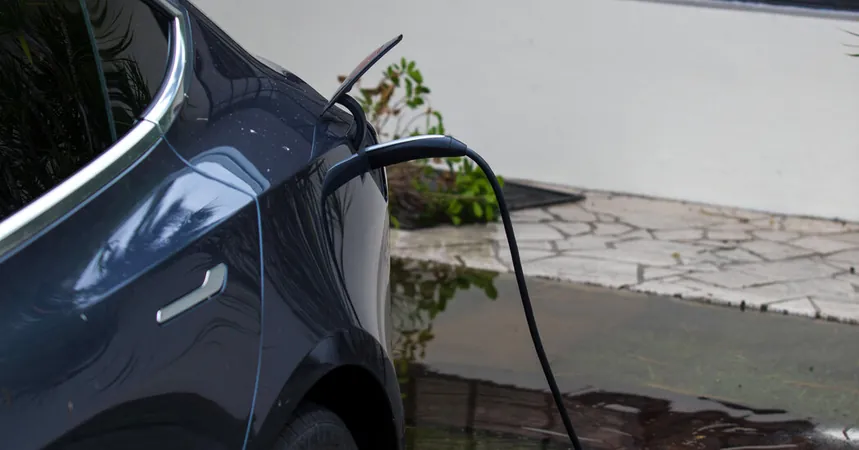
The Shocking Truth: Can Your Electric Vehicle Ignite During a Hurricane?
2024-10-10
Author: Wei
As Florida braces for Hurricane Milton, officials are urging residents to take precautions regarding their electric vehicles (EVs). The warning is clear: move your EV away from flood-prone areas to avoid the potentially dangerous situation where cars may ignite if submerged in saltwater for too long.
“This is a serious risk that people should be aware of,” stated a representative from Hillsborough County, which includes Tampa. The concern arises primarily from the lithium-ion batteries that power electric vehicles, as well as e-bikes, scooters, and other electric devices. These batteries can ignite after being exposed to saltwater, posing a significant fire hazard.
While such incidents are relatively rare, they have happened. For example, during Hurricane Helene, 11 out of 48 lithium-ion battery fires were attributed to electric vehicles. This statistic highlights that even though less than 0.01% of Florida's 254,000 registered EVs faced this fate, the risk still exists.
Why Are Batteries Vulnerable to Flooding?
When saltwater infiltrates a lithium-ion battery, it can create electrical shorts between the battery’s positive and negative terminals. This short-circuiting results in heat generation, which can trigger thermal runaway—a dangerous chain reaction that causes one battery cell to overheat and, in turn, affect neighboring cells. This could lead to a fire lasting hours and challenging to extinguish.
Although manufacturers design lithium-ion batteries to be water-resistant, prolonged exposure to saltwater can diminish their protective capabilities. “Freshwater doesn’t pose the same risk,” noted Albert Gore, executive director of the Zero Emission Transportation Association. Residents in coastal areas must remain especially vigilant.
How to Ensure Your Safety
After Hurricane Ian’s devastation in 2022, 3,000 EVs were flooded, but only 36 ignited, as per a report by the Idaho National Laboratory. “It’s not super common,” commented Thomas Barth, from the National Transportation Safety Board, emphasizing the rarity of such events.
To mitigate risks, vehicle owners are advised to charge their electric vehicles to 20-30% if anticipating flooding and relocate them to higher ground, such as a parking garage rooftop. Parking at a minimum of 50 feet away from flammable structures like homes or trees is also recommended. For those with e-bikes, removing and securing the battery before a storm can significantly reduce fire risks if flooding occurs.
What to Do If Your Electric Vehicle Was Submerged
If your EV has been submerged in floodwaters, avoid driving it. Damage that remains invisible can lead to fires that spark days or even weeks after the flood subsides. Contact your vehicle's manufacturer for a thorough inspection and inform them of the flooding situation.
Are Firefighters Prepared?
Electric vehicle fires require specific handling techniques. Firefighters must carefully apply water to designated areas around the battery to cool it down; incorrect methods could lead to reignition. While 350,000 firefighters have received training on extinguishing EV fires, there remains a significant knowledge gap among the total 1.2 million firefighters across the nation.
As storms become more intense due to climate change, the risks associated with electric vehicles during hurricanes will continue to grow. Staying informed and prepared is essential for every electric vehicle owner facing these climatic challenges. Don't become another statistic—know the risks and keep your vehicle, and your community, safe!


 Brasil (PT)
Brasil (PT)
 Canada (EN)
Canada (EN)
 Chile (ES)
Chile (ES)
 España (ES)
España (ES)
 France (FR)
France (FR)
 Hong Kong (EN)
Hong Kong (EN)
 Italia (IT)
Italia (IT)
 日本 (JA)
日本 (JA)
 Magyarország (HU)
Magyarország (HU)
 Norge (NO)
Norge (NO)
 Polska (PL)
Polska (PL)
 Schweiz (DE)
Schweiz (DE)
 Singapore (EN)
Singapore (EN)
 Sverige (SV)
Sverige (SV)
 Suomi (FI)
Suomi (FI)
 Türkiye (TR)
Türkiye (TR)